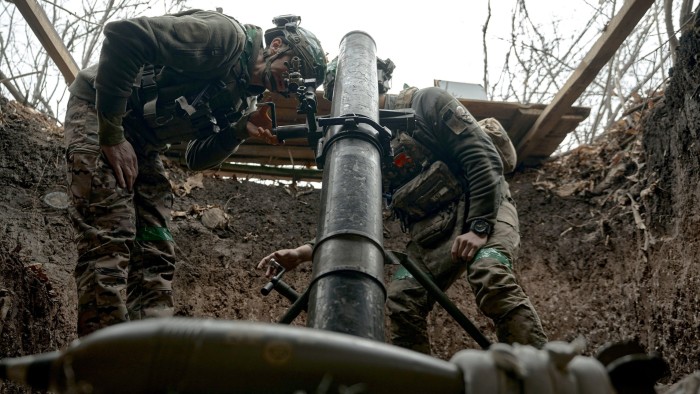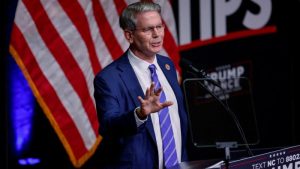Ukraine and Russia fight for advantage ahead of Trump return

Ukraine’s military is rushing medics to the frontline in anticipation of an intensified Russian onslaught as both sides fight for territorial advantage before Donald Trump returns to the White House.
Military officials, soldiers and analysts see the next few months as a critical phase in the war, with Ukraine attempting to stabilise defences and strengthen its position in case it is forced to negotiate with Moscow by the incoming US president.
Moscow has ramped up attacks in recent months and Ukraine’s forces have been unable to hold the line in the east, where Russian forces are now advancing at a faster rate than at any point since 2022. Ukrainian officials have admitted that their defences are “crumbling” amid manpower shortages.
Kyiv expects the offensive to gather pace and a Ukrainian army spokesperson told the Financial Times that more medical personnel is being sent to the eastern front in anticipation of heavy battles in the coming days and weeks, “particularly in the south and east”.
A key battle is also shaping up in Russia’s Kursk region, parts of which Ukraine seized in a surprise incursion in August. But Russia is now readying a force of about 50,000 soldiers, including from North Korea, in a fresh attempt to push the Ukrainians back, according to President Volodymyr Zelenskyy and western intelligence officials.
Trump has pledged to “end the war in 24 hours” after taking office and has criticised US military aid for Ukraine. Russian President Vladimir Putin has signalled openness to talks, sparking concern in Kyiv and other European capitals that the US president-elect may back a deal that favours Moscow.
But if Ukraine was able to stop Russia’s offensive and seize the initiative by the time Trump takes office on January 20, senior Ukrainian officials believe they could prove they are “fighters” and “winners” and help convince the president-elect to stand by them.
In Kursk, Russia is rushing to take back at least the city of Sudzha, where Ukraine has set up a military command, if not all of the Ukrainian-held territory before Trump is sworn in in January, according to the Centre for Defence Strategies (CDS), a Kyiv-based security think-tank.
The 10,000 North Korean troops recently deployed to fight alongside Russian soldiers could help tilt the balance in Moscow’s favour in Kursk region. “It’s a huge number. You cannot disregard it,” said a senior western security official.
Losing Kursk would deprive Zelenskyy of a valuable bargaining chip in any potential talks with Moscow, which he has said he would enter only if Russia completely withdrew from Ukraine.
Putin, whose army has made steady gains in recent months, has expressed interest in negotiations only if Kyiv accepts all his demands — including stretching the Russian occupation to the entirety of Ukraine’s six occupied eastern and southern regions, none of which Russia controls in full except for Crimea.
Since August, Russia has captured over 1,200 sq km in Ukraine, according to Deep State, a Ukrainian war tracking group closely tied to the defence ministry. That is double what Kyiv’s troops currently hold in Kursk region, Deep State data shows.

At several flashpoints across the 1,000km-long frontline, Ukraine’s troops are enduring relentless Russian air and ground assaults. A commander of an artillery unit near Kurakhove where the fighting is most intense told the FT on Monday that Russian troops were “attacking from three sides”. He and his troops “are ready to pull back” he said, “but we do not have the order from the top yet”.
Kurakhove and the city of Pokrovsk 40km north are both critical logistical hubs for Ukraine’s army and are now largely destroyed. The coking plant on the outskirts of Pokrovsk which has also come under attack is the largest in Ukraine and crucial to its steel manufacturing industry.
CDS, the military think-tank, estimated that by December, “the front line will probably shift 30-35 km west of its current position”.
Major General Dmytro Marchenko last month said that the eastern front was “crumbling” owing to shortages of ammunition and manpower. “People are very exhausted. They simply cannot hold the fronts they are on,” he said.

Manpower, especially infantry, remains Ukraine’s biggest challenge, according to commanders and analysts.
“The average age is already above 40 in various brigades and there doesn’t seem to be enough reinforcements arriving on the frontline,” said Franz-Stefan Gady, a military analyst and fellow at the International Institute for Strategic Studies in London who recently visited Ukraine.
Ukraine is planning to draft an additional 160,000 troops between November and February, which the National Security and Defence Council believes would only replenish military units to about 85 per cent of what was needed.
But military experts and one senior Kyiv official have expressed scepticism that the target will be reached, saying it was more realistic to expect up to 100,000 to be drafted. That would fill about half of the manpower gap, they said, which would still be an improvement as some units are currently staffed to about a third of what was needed.
Several Ukrainian commanders and soldiers have said efforts to attract more men to the army were hampered by military service being open-ended. Kyiv has been wary of passing a law on demobilisation for fear it could lead to an exodus of soldiers.
“A lot of guys now see mobilisation as a death sentence,” said one senior soldier who joined the army in spring 2022 and has not had a break since.
Stanislav Aseyev, a prominent Ukrainian journalist turned soldier, said that “without a clear answer about the period of service and quality of training, the recruits will be as demoralised and ineffective as the current battle-weary infantry”.

To make up for the shortages, some infantry units have been allegedly bolstered with air force pilots, engineers, medics and surgeons, according to Mariana Bezuhla, an MP on the foreign policy committee, who was echoing concerns first made public by frontline soldiers.
Colonel Yuriy Ignat, a senior air force official, earlier this month said that some air force personnel had been transferred to frontline units, citing the challenging circumstances.
However, a Ukrainian army spokesperson strongly denied the allegations and said that Ignat had misspoken. “Air force units, including engineers, pilots, maintenance staff, and medical teams, remain in their specialised positions,” the spokesperson said, adding that more medics were being sent to the “stabilisation points” closest to the frontline in anticipation of more intense fighting and heavier casualties.
Two commanders leading units on the eastern front said skilled personnel, including medics, had been previously deployed to the infantry. “War requires these things sometimes,” said one of the commanders. “I’ve sent my cooks to the trenches before.”
Dara Massicot, a senior fellow at the Carnegie Endowment for International Peace who recently visited the front lines, said that Russia is “just overwhelming the Ukrainians because they have more resources now.”
“They may not be skilled attacks, but the consistency and frequency of these things is wearing down the Ukrainian side,” she said.

Russia’s gains have come at enormous cost. UK defence chief Admiral Sir Tony Radakin recently estimated that Moscow’s troops suffered about 1,500 dead and injured “every single day” in October, with its overall casualties since February 2022 reaching 700,000.
Russia has sharply raised the payouts for signing up to fight in Ukraine in recent months, indicating the army is struggling to recruit more men. But the enormous sums on offer have also inured ordinary Russians to the casualties their forces are sustaining in Ukraine, Massicot said.
“What that does to the rest of the Russian population is they look at them and go, ‘Well, they’re just in it for the money.’ And when they’re killed, the response is they knew what they were signing up for,” she said.
North Korea could also deploy a second wave of troops to bolster Russia’s manpower advantage. Kim Jong Un, its leader, has about 20,000 soldiers he could dispense of and has supplied Russia with $5.5bn worth of military support, according to a report published in October by the Friedrich Naumann Foundation for Freedom.
“Any advantage in manpower and equipment counts,” the western security official said. Though Russia will probably run into difficulties maintaining its arms manufacturing rates by the end of next year, “Ukraine has much bigger problems now”.
Cartography by Steven Bernard
#Ukraine #Russia #fight #advantage #ahead #Trump #return





